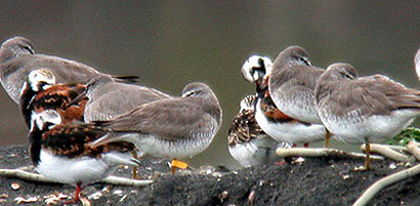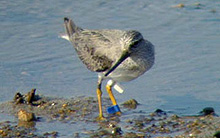East Asian-Australasian Flyway partnership

Photo © Yeh Chih wei
The programme of flagging waders has revolutionised wader migration studies, and probably more waders have been flagged in recent years than have ever been flagged before - and, if the destruction of wetlands continues, probably ever will be.
The programme started in Australia in 1990, and a flagging protocol has been developed for the East-Asian Australasian Flyway, which enables any country, or in some cases regions within a country, to join the scheme.
At present Australia, New Zealand, Japan, South Korea, China (Hong Kong) and Taiwan are colour flagging birds.
The Australasian Wader Studies Group has now assumed responsibility for processing all leg flag markings in Australia under agreement with, and with limited financial support from, Environment Australia which is the Environment Portfolio of the Commonwealth Government of Australia.
The "flag" is a small coloured plastic band with a tab on the end. Flags can be placed either on the upper part of the leg (the tibia), the lower (the tarsus), or both upper and lower.

Easily seen by an observer, it means that, unlike with banding/ringing, the bird does not have to be re-caught to find out in which region it has been banded.
For birds from Victoria, S.E. Australia, the reporting rate from flagged birds is 17 times that of banded bands, and for N.W. Australia 5 times.
Also flagged birds can be watched for anywhere, as opposed to banded birds for which most recoveries only come from a few areas where there is much hunting or banding activity. For some species and localities in the Flyway where there have been many flag sightings it is now becoming possible to find out the timings of migrations of birds from different origins (i.e. N.W. and S.E. Australia: Alaska and Siberia) through the same area, and even to make estimates of the proportions of the total populations passing through.

Japan. Photo © Sayaka Sakomoto
The table below lists the the colours of the flags being placed on waterbirds by countries following the AWSG protocol: in the table, upper/lower refers to the part of the leg that the flag is placed on.
All countries starting flagging are urged to follow the protocol.
The colour scheme has been carefully worked out to ensure that all researchers throughout the Flyway benefit from the program, and do not destroy other people's research, (and their own), by not following the protocol.
(More information on Colour Flagging can be found on the East Asian-Australasian Flyway partnership website.)
| White | Black | Blue | Green | Orange | Yellow |
| nothing | nothing | nothing | nothing | nothing | nothing |
| North Island | Southern India | Northern Japan Shunkunitai, Eastern Hokkaido | QLD | Victoria | NWA |
| may be engraved | (on left leg) | (on left leg) | may be engraved | may be engraved | may be engraved or carrying four other color bands |
| New Zealand | India | Japan | Australia | Australia | Australia |
| White | Black | Blue | Green | Orange | Yellow |
| White | White | White | White | White | White |
| Northern India | Chongming Island | Tokio Bay & Miyagi | East. Yellow Sea | Sakhalin Island | |
| (both flags on right tibia) may be engraved | Tibia & Tarsus: Obitsu (typical flag); Yatsu Tidal Flat (angled flag) Both Tarsus: Miyagi pref. (on left legs) may be engraved | discontinued | may use angledflags in future | ||
| India | China | Japan | Singapore | South Korea | Russia |
| White | Black | Blue | Green | Orange | Yellow |
| Black | Black | Black | Black | Black | Black |
| Chongming Island | Hainan-Guangxi | Sumatra | Kamchatka | ||
| discontinued | may use angled flags in future | ||||
| China | Myanmar | China | Cambodia | Indonesia | Russia |
| White | Black | Blue | Green | Orange | Yellow |
| Blue | Blue | Blue | Blue | Blue | Blue |
| Taiwan | Northern Japan Lake Komuke, Northern Hokkaido | Jiangsu | Tasmania | Northern Territory | |
| may be engraved | may be engraved | ||||
| China | Philippines | Japan | China | Australia | Australia |
| White | Black | Blue | Green | Orange | Yellow |
| Green | Green | Green | Green | Green | Green |
| South Island | Inner Gulf of Thailand | NSW | |||
| Angled (left leg): Thailand Peninsular (Ko Libong) Typical (right leg): Gulf of Thailand may be engraved | may be engraved | ||||
| New Zealand | Thailand | Mongolia | Sri Lanka | Australia | Vietnam |
| White | Black | Blue | Green | Orange | Yellow |
| Orange | Orange | Orange | Orange | Orange | Orange |
| East. Yellow Sea | Java & Bali | Southern Japan | Yalujiang | West Papua | SW West. Aus. |
| Tibia & Tarsus: Kyushu Both Tarsus: Okinawa may be engraved | may be engraved or carrying other color bands | may be engraved | |||
| South Korea | Indonesia | Japan | China | Indonesia | Australia |
| White | Black | Blue | Green | Orange | Yellow |
| Yellow | Yellow | Yellow | Yellow | Yellow | Yellow |
| Hong Kong | Bohai Bay | Gulf of Carp. | SA | ||
| (proposed) | typical: Tangshan angled: Cangzhou | may be engraved | may be engraved | ||
| China | Malaysia | China | Australia | Australia | Bangladesh |
| Pale Green | Pale Green | Pale Blue | Pale Blue | Pale Blue (ring) | Green (ring) |
| nothing | White | nothing | White | Green | Green |
| Southern Chukotka | Southern Chukotka | Northern Chukotka | Wrangel Island | Northern Alaska Ikpikpuk & Prudhoe Bay | Northern Alaska Canning River |
| white may be engraved | markings can be placed on different parts of legs | markings can be placed on different parts of legs | |||
| Russia | Russia | Russia | Russia | USA | USA |
| Orange (ring) | Red (ring) | Yellow (ring) | Blue (ring) | Black | Red |
| Green | Green | Green | Green | nothing | nothing |
| North western Alaska | Northern Alaska Barrow | Northern Alaska Barrow | Western Alaska Nome | South Island | |
| may be engraved;markings can be placed on different parts of legs | markings can be placed on different parts of legs | Bar-tailed Godwits engraved | NOT engraved, may carrying four other color bands | ||
| USA | USA | USA | USA | New Zealand, Australia & USA | New Zealand |
| Yellow | White | ||||
| nothing | nothing | ||||
| New Zealand Pied Oystercatchers haematopus finschi engraved | Variable Oystercatchers Haematopus unicolor engraved | ||||
| New Zealand | New Zealand | ||||
| Updated: 24 Jun 2013 | |||||



